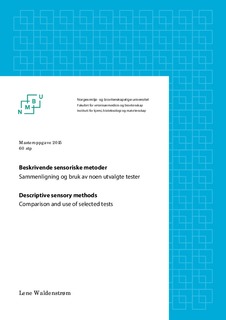| dc.description.abstract | In recent years, the growing demand for cost efficiency within product development in the food Industry, have created a need for rapid descriptive sensory methods. Several new rapid methods have subsequently been developed.
The overall aim of this thesis was to compare the two rapid methods Napping® and CATA, and compare them with the established method profiling (QDA). The thesis includes three studies.
Study 1 compared Global and Partial Napping® with traditional profiling (QDA). In this study, the semi-trained panel at Sør-Trøndelag University College, Department of Food Technology, tested eight different types of strawberry yoghurt. Napping®, in particular Partial Napping®, was less time consuming and proved to give a better product description than profiling. In addition, consumer acceptance, of the same strawberry yoghurts, were examined and presented together with the profiling data in a Preference Map.
In Study 2, CATA and Global Napping® were compared for consumer testing of five different brands of orange juice. CATA turned out to be easier for the consumers to understand and perform. Moreover, processing and interpretation of data and plot was easier using CATA than Napping®. The number of descriptive words created by use of Global Napping ® complicated interpretation of the plot.
The final part, Study 3, compared CATA with profiling (QDA). In this study, the same semi-trained panel used in Study 1 profiled four varieties of vegetable juice whereas consumers performed CATA. The rapid method CATA provided similar product descriptions as profiling, as well as information about consumer acceptance and preferred usage.
Profiling requires repeated tests and a trained sensory panel of professional assessors. The fact that untrained and unpaid consumers can perform Napping® and CATA as a single test, are advantages compared to traditional profiling.
Profiling with a trained sensory panel, will sometimes give information that the rapid methods cannot provide. For instance, if small differences in one specific attribute is considered, or if shelf life of a product is tested. A trained sensory panel will also provide more precise and unambiguous product descriptions than a consumer panel.
Hovedmålet i denne oppgaven ble formulert til bruk og vurdering av de beskrivende hurtigmetodene Napping® og CATA samt sammenligning med den etablerte sensoriske metoden profilering (QDA).
Oppgavens første del, Studie 1, gikk ut på å sammenligne Global og Partial Napping® med profilering (QDA).
Studie 2 gikk ut på å sammenligne CATA og Global Napping® når begge disse ble brukt til forbrukertesting av 5 ulike appelsinjuice.
I Studie 3 ble CATA og profilering (QDA) sammenlignet. | nb_NO |
